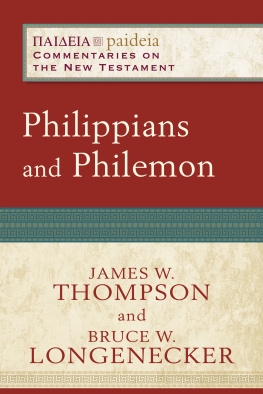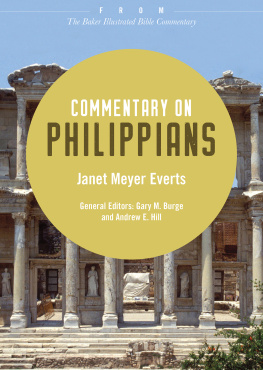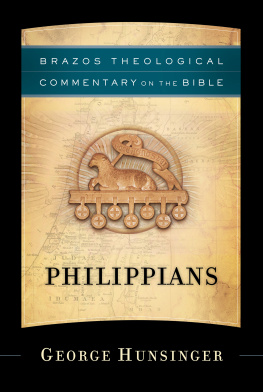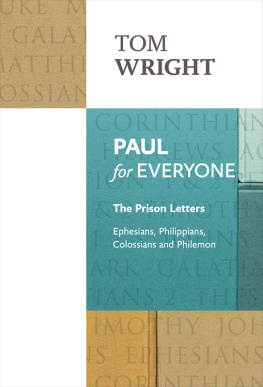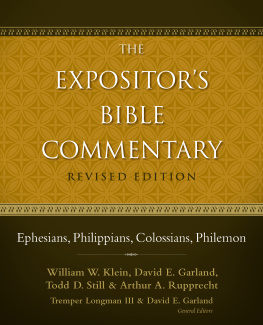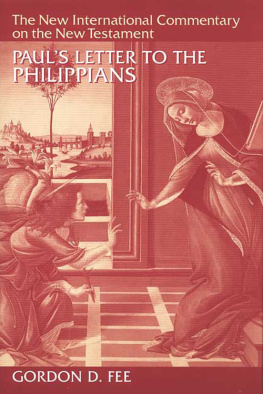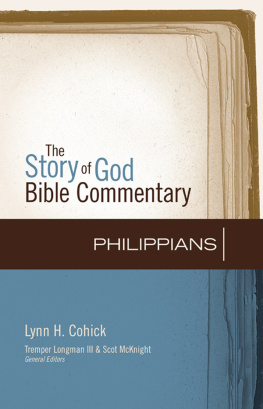Mikeal C. Parsons, Charles H. Talbert, and Bruce W. Longenecker
Paul J. Achtemeier
C. Clifton Black
Susan R. Garrett
Francis J. Moloney
Copyright Page
Philippians 2016 by James W. Thompson
Philemon 2016 by Bruce W. Longenecker
Published by Baker Academic
a division of Baker Publishing Group
P.O. Box 6287, Grand Rapids, MI 49516-6287
www.bakeracademic.com
Ebook edition created 2016
All rights reserved. No part of this publication may be reproduced, stored in a retrieval system, or transmitted in any form or by any meansfor example, electronic, photocopy, recordingwithout the prior written permission of the publisher. The only exception is brief quotations in printed reviews.
Library of Congress Cataloging-in-Publication Data is on file at the Library of Congress, Washington, DC.
ISBN 978-1-4934-0427-8
Unless otherwise indicated, all Scripture quotations are the authors own translations.
Scripture quotations labeled NIV are from the Holy Bible, New International Version. NIV. Copyright 1973, 1978, 1984, 2011 by Biblica, Inc. Used by permission of Zondervan. All rights reserved worldwide. www.zondervan.com
Scripture quotations labeled NRSV are from the New Revised Standard Version of the Bible, copyright 1989, by the Division of Christian Education of the National Council of the Churches of Christ in the United States of America. Used by permission. All rights reserved.
Dedication
J. W. T.
For my grandchildren,
Elizabeth Anne Bryant
Benjamin Thompson Bryant
Andrew William Thompson
Gabrielle Lynn Thompson
B. W. L.
For my mother,
Frances Lee Wilson Longenecker,
currently enslaved to Alzheimers
but soon to be released forever
Contents

| Cover |
| Title Page |
| Copyright Page |
| Dedication |
| List of Figures and Tables |
| Foreword |
| Abbreviations |
| Philippians |
| Introduction to Philippians |
| Philippians 1:111 | Part 1, Exordium : Thanksgiving and Prayer for Moral Formation |
| Philippians 1:1226 | Part 2, Narratio : The Present and Future Advance of the Gospel |
| Philippians 1:2730 | Part 3, Propositio : Citizens United in an Alternative Commonwealth |
| Philippians 2:14:1 | Part 4, Probatio : Examples of Faithful Living |
| Philippians 2:111 | The Ultimate Example |
| Philippians 2:1218 | Following the Example of Christ |
| Philippians 2:1930 | The Examples of Timothy and Epaphroditus |
| Philippians 3:14:1 | The Example of Paul |
| Philippians 4:223 | Part 5, Peroratio : Summarizing the Case |
| Philemon |
| Introduction to Philemon |
| Philemon 13 | Setting the Scene, Part 1 |
| Philemon 47 | Philemons Character, as Illustrated by His Past Actions |
| Philemon 816 | Setting the Scene, Part 2 |
| Philemon 1722 | Living Up to Character |
| Philemon 2325 | Final Greetings |
| Bibliography |
| Index of Subjects |
| Index of Modern Authors |
| Index of Scripture and Ancient Sources |
| Back Cover |
Figures and Tables

Figures
1. Map of Macedonia
2. The Via Egnatia
3. The Roman Forum
4. The Crenides River
5. Paul in Prison
6. The Death of Socrates
7. Christ Pantocrator
8. A Libation Cup
9. Pauls Encounter on the Road to Damascus
10. Greek Runners
11. Mosaic Honoring the Apostle Onesimus
12. Map Showing the Cities of Ephesus and Colossae
13. Map Showing the Cities of Rome and Colossae
14. Rhetorical Squeeze of Philemon 1 and 25
Tables
1. Interpretive Possibilities for the First Clause of Philemon 6
Foreword

Paideia: Commentaries on the New Testament is a series that sets out to comment on the final form of the New Testament text in a way that pays due attention both to the cultural, literary, and theological settings in which the text took form and to the interests of the contemporary readers to whom the commentaries are addressed. This series is aimed squarely at studentsincluding MA students in religious and theological studies programs, seminarians, and upper-division undergraduateswho have theological interests in the biblical text. Thus, the didactic aim of the series is to enable students to understand each book of the New Testament as a literary whole rooted in a particular ancient setting and related to its context within the New Testament.
The name Paideia (Greek for education) reflects (1) the instructional aim of the seriesgiving contemporary students a basic grounding in academic New Testament studies by guiding their engagement with New Testament texts; (2) the fact that the New Testament texts as literary unities are shaped by the educational categories and ideas (rhetorical, narratological, etc.) of their ancient writers and readers; and (3) the pedagogical aims of the texts themselvestheir central aim being not simply to impart information but to form the theological convictions and moral habits of their readers.
Each commentary deals with the text in terms of larger rhetorical units; these are not verse-by-verse commentaries. This series thus stands within the stream of recent commentaries that attend to the final form of the text. Such reader-centered literary approaches are inherently more accessible to liberal arts students without extensive linguistic and historical-critical preparation than older exegetical approaches, but within the reader-centered world the sanest practitioners have paid careful attention to the extratext of the original readers, including not only these readers knowledge of the geography, history, and other contextual elements reflected in the text but also their ability to respond correctly to the literary and rhetorical conventions used in the text. Paideia commentaries pay deliberate attention to this extratextual repertoire in order to highlight the ways in which the text is designed to persuade and move its readers. Each rhetorical unit is explored from three angles: (1) introductory matters; (2) tracing the train of thought or narrative or rhetorical flow of the argument; and (3) theological issues raised by the text that are of interest to the contemporary Christian. Thus, the primary focus remains on the text and not its historical context or its interpretation in the secondary literature.
Our authors represent a variety of confessional points of view: Protestant, Catholic, and Orthodox. What they share, beyond being New Testament scholars of national and international repute, is a commitment to reading the biblical text as theological documents within their ancient contexts. Working within the broad parameters described here, each author brings his or her own considerable exegetical talents and deep theological commitments to the task of laying bare the interpretation of Scripture for the faith and practice of Gods people everywhere.

